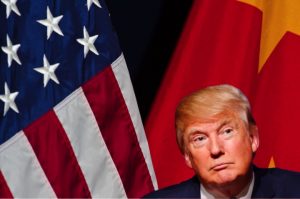Trade War Back On: Trump Moving Forward with Tariffs on China

Picture of Donald Trump by Michael Vadon. U.S. & Chinese flags added.
Barely more than a week after Treasury Secretary Steven Mnuchin went on Fox News Sunday and said the trade war with China is on hold, the White House announced in a statement today (May 29th) that the United States will impose a 25 percent tariff on $50 billion of goods imported from China.
The statement lines up with President Trump’s announcement back on March 22nd of planned levies on $50 billion worth of imports from China that quickly escalated into both China and the U.S. threatening $150 billion worth of tariffs on the other country’s goods.
If you’re already feeling dizzy from tariffs between the U.S. and China being announced, escalated, on hold, back on… well, you may find yourself throwing up soon.
It is likely the purpose of this White House statement, including the announcement these tariffs will be imposed, is to create leverage for the trade negotiations Commerce Secretary Wilbur Ross is heading to Beijing at the end of this week to continue with China.
Today’s White House statement was brief, but it gives the following information about imposing tariffs on China.
Under Section 301 of the Trade Act of 1974, the United States will impose a 25 percent tariff on $50 billion of goods imported from China containing industrially significant technology, including those related to the “Made in China 2025” program. The final list of covered imports will be announced by June 15, 2018, and tariffs will be imposed on those imports shortly thereafter.
That tariffs announcement was actually the third action update in the statement. Here are the other two:
- To protect our national security, the United States will implement specific investment restrictions and enhanced export controls for Chinese persons and entities related to the acquisition of industrially significant technology. The proposed investment restrictions and enhanced export controls will be announced by June 30, 2018, and they will be implemented shortly thereafter.
- The United States will continue to pursue litigation at the World Trade Organization for violations of the Agreement on Trade-Related Aspects of Intellectual Property Rights based on China’s discriminatory practices for licensing intellectual property. The United States filed the case regarding these violations on March 23, 2018.
After listing those three actions, the statement summed up with the following:
… the United States will continue efforts to protect domestic technology and intellectual property, stop noneconomic transfers of industrially significant technology and intellectual property to China, and enhance access to the Chinese market. Likewise, the United States will request that China remove all of its many trade barriers, including non-monetary trade barriers, which make it both difficult and unfair to do business there. The United States will request that tariffs and taxes between the two countries be reciprocal in nature and value. Discussions with China will continue on these topics, and the United States looks forward to resolving long-standing structural issues and expanding our exports by eliminating China’s severe import restrictions.
While this statement was pretty short, the White House also published today a press release, labeled as a fact sheet, titled “President Donald J. Trump is Confronting China’s Unfair Trade Policies”.
While highlighting China’s unfair trade practices with the U.S.—including dumping, discriminatory non-tariff barriers, forced technology transfer, over capacity, and industrial subsidies—and the actions of the Trump administration to fight these practices, the press release underscores the U.S. deficit with China.
Trump has loudly bemoaned this deficit, which the press release says was $375 billion in 2017 alone, since he was on the campaign trail to become president.
While it’s a matter of debate if a trade deficit between countries actually is a bad thing, President Trump certainly believes the one between the U.S. and China is very bad. Therefore, the U.S. trade deficit is at the center of President’s Trump’s trade action and trade negotiation with China.
Until action and agreement between the U.S. and China is set to significantly decrease the trade deficit, expect drama over tariffs to appear in the news cycle. But it would not be surprising at all to hear from the Trump administration that the tariffs, and the trade war to go along with them, are on hold again after Ross completes his upcoming meetings with Chinese officials.




